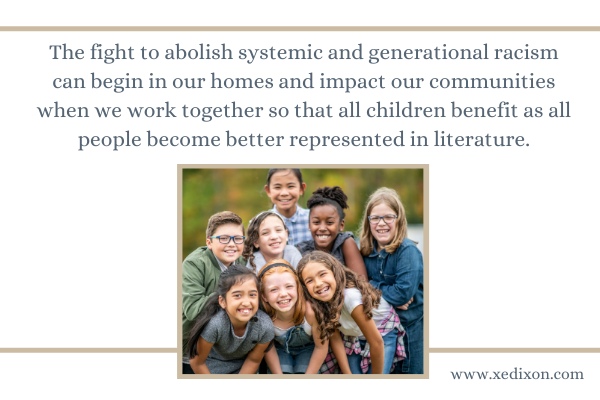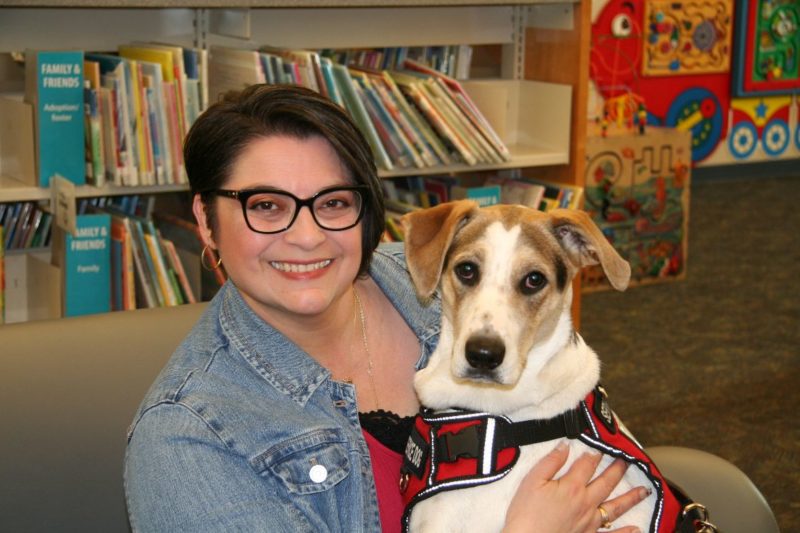Are You Willing to Change What’s in Your Library?

As I prepare to welcome my first grandchild, I’m dreaming of the perfect spot for my personal library. I’m imagining the shelves, the seating, and the walls of books displayed in this room. Yes. Walls. Yes. A whole room.
While I work to make this dream-room a reality, I’m also adding to my already-too-long list of titles that must be included in my already-overflowing collection of children’s picture books.
Which classic books must be present? Which Christmas books will become a part of our yearly reading traditions as I snuggle next to the fireplace (still also a figment of my imagination) and read to our next generation of God’s littlest image-bearers?
Reviewing my current collection of children’s picture books brought me joy and dismay when I realized my colorful collection failed to accurately represent my colorful life.
As a first-generation Mexican American married to a Black man, I deliberately purchased books that included main characters of color for my personal library over the years.
Ezra Jack Keats holds a special place in my heart and will hold a section in my library.
But as I scanned my collection, I couldn’t ignore its limitations.
How could I have been so blind? Why didn’t I think it was strange when I got so excited to see illustrations that included diverse characters?
The answer caused me to dig deeper than I’ll be going in this post. However, the root of my problem quickly led me to explore my wonder years.
Being raised by immigrant parents filled me with sour pebbles of compromise and denial of culture in pursuit of assimilation and acceptance into what they perceived as acceptable “American” culture.
My mother changed my middle name to English and switched it with my first name when she registered me for school. She hoped to make it easier for the teachers who would never be able to pronounce my name correctly. She thought I would avoid being teased by fellow students who thought my name was weird.
Little did she know that, as a creative, I would be teased for so many more reasons than a name with a rich cultural history.
It wasn’t until I discovered my identity in Christ that I grew brave enough to embrace God’s intentionality in creating my uniqueness, which is vital to celebrating the diversity of all Creation.
But it wasn’t until 2003, when I first shared the manuscript for Different Like Me with an editor, that I realized I wanted to make a difference in the lives of children through celebrating diversity and inclusion with my creative talents.
I trusted God with my writing journey and my search to find more books that would help my library look more like my diverse family and friends. However, I discovered the lack of titles representing people of color was a problem in the publishing world not just my small private library.
A 2019 Huffpost article mentions a graphic inspired by Dr. Rudine Sims Bishop’s reference to books as “mirrors, reflecting our own lives back at us, and that reading is therefore a means of self-affirmation” (“Kids Books Still Have a Lack-of-Diversity Problem, Powerful Image Shows,” Natalie Stechyson, Huffpost).
I couldn’t hold back the tears when I looked at the image, “Diversity in Children’s Books 2018,” created the same year that I signed the contract for Different Like Me. Though I wasn’t surprised by the statistics in that graphic and in a similar image for the 2015 statistics, the reality broke my heart.
I’d written Different Like Me in 2001 after my youngest son’s first experience responding to a racial slur without me by his side. I wanted to empower him to respond to systemic and generational racism with God’s truth and love.
I wanted to teach my sons to celebrate our differences and our sameness as God’s beautifully diverse and purposefully connected people.
Still, as an avid reader, it hurt every time I was reminded that we were invisible in literature unless the story was specifically about something directly tied to our culture. Even with those books, my sons couldn’t totally relate to the characters. After all, as I’d been told by professionals in the publishing industry, it wasn’t like I was “really Mexican” and it wasn’t like my children were “really Black.” (Yes. People really say these things to me.)
So how could my biracial children find a place to belong, to rejoice in their diversity, to celebrate their uniqueness?
How can all children be taught to celebrate diversity and rejoice in their uniqueness as God’s image-bearers, who are designed to be different and work together?
We can be intentional about the books we write, the books we illustrate, the books we include in our libraries at home, the books we request at the public libraries, and the books we purchase as gifts?
When my publisher searched for an illustrator for Different Like Me, I gave them a simple request. I wanted an artist who would abolish stereotypes and include children with special needs as heroes not sideline images.
I’m so glad I have the opportunity to make a difference for my grandchildren with the books I write and the books I choose to include in my private library.
Whether you are a children’s book writer or an adult who is passionate about nurturing a love for reading in children, you can make a difference in changing these statistics.
The fight to abolish systemic and generational racism can begin in our homes and impact our communities when we work together so that all children benefit as all people become better represented in literature.
Are you willing to change what’s in your library?
***

Xochitl Dixon, Our Daily Bread writer and author of Waiting for God: Trusting Daily in God’s Plan and Pace (2019) and the children’s book Different Like Me (2020), empowers readers to be rooted in God’s Word while growing with God’s people through strong biblical teaching and Scripture-based prayers at www.xedixon.com.

Excellent post. I’m glad you are putting your talents to work to write this kind of book as there is truly a great need for them. Praying God will bless you as you write them and have publishers ready to put them into print.
Thanks for your encouragement and support, Janice. I thank God for the stories He’s giving me to share and for the ways He is moving in the hearts of illustrators who are passionate about creating art that touches children intimately and empowers them personally. I am excited to see how our book shelves change as we become intentional about celebrating diversity and rejoicing in the ways we are intentionally created to word together in unity and peace.
Wonderful post, Xochi! It may take years, but I believe we are turning the corner and moving in the right direction to have more diverse characters in children’s literature. Writers and illustrators need to be intentional about inclusion, and buyers need to be intentional about buying books with diverse characters. The bottom line is that if the books don’t sell, publishers won’t publish them.
Thanks for your loving support over the years, Crystal. You are so right! We are turning the corner and moving in the right direction. Intentionality is key. I’ve been intentional about purchasing books that celebrate diversity and that honor Christ. I just added M is for Manger to my personal library. I don’t even know how I hadn’t heard about M is for Manger before this year. We need help spreading the word about quality Christian books and books that celebrate diversity and inclusion. I thank God for your faithfulness to God’s Holy Word and pray I will be so faithful in all I write. You have inspired me and encouraged me more than you know, Sister.
Such a thoughtful post, Xochi! Thank you for writing it and for being part of this group!